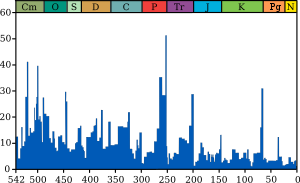Kambro-Ordovician mass extinction
The Kambro-Ordovician mass extinction , English Cambrian-Ordovician extinction event or Top of Cambrian excursion , abbreviated TOCE , occurred off around 488 million years BP at the end of the Cambrian . Many brachiopods , conodonts and radiolarian genera fell victim to this mass extinction in the early Phanerozoic , and the number of trilobite taxa was also drastically reduced.
Historical framework

This was preceded by the poorly documented mass extinction at the end of the botomium around 517 million years ago BP (end botomic mass extinction ) and the mass extinction of the Dresbachium 502 million years ago BP.
The Cambrian-Ordovician mass extinction ended the Cambrian and led to the Paleozoic period of the Ordovician .
Effects on biodiversity
Lauren Pouille and colleagues (2011) convey in their study of radiolarians from the Cow Head Group of Newfoundland a good picture of the impact of the event at the upper limit has not yet designated stage 10 of the Cambrian. The effects were selective extinctions and changes in fauna at the level of the species , decreasing biodiversity, extinction, but also species diversification within the examined radiolarians. Of 19 taxa encountered, 12 disappeared, ie a species loss of 63%. Three genera completely disappeared, including Ramuspiculum , Subechidnina and Grosmorneus . Within the genus Echidnina alone three out of five taxa disappeared, ie 60% died out. Only in the Tremadocium did 8 new taxa appear next to the passers-through.
Carbon isotope excursion
The Kambro-Ordovician mass extinction was accompanied by a clearly negative excursion of the δ 13 C values, which decreased from +1 to −4 ‰ PDB.
causes
Several theories exist to explain the causes of mass extinction, including:
- Assumption of a strong cooling of the climate or the onset of a global cold period
- Anoxic conditions in the ocean
- Catastrophic flood basalt volcanism in a Magmatic Greater Province , in this case triggered by the Magmatic Greater Province of Kalkarindji in Western Australia .
literature
- Felix Gradstein, James Ogg and Alan Smith: A Geologic Time Scale 2004 . Cambridge University Press, 2004.
- Anthony Hallam and Paul B. Wignall: Mass extinctions and their aftermath . Oxford University Press, 1997.
- Barry D. Webby and Mary L. Droser: The Great Ordovician Biodiversification Event . Columbia University Press, 2004.
Individual evidence
- ↑ Pouille, L. et al: Radiolarian diversity changes during the late Cambrian-early Ordovician transition as recorded in the Cow Head Group of Newfoundland (Canada) . In: Marine Micropaleontology . 2013, doi : 10.1016 / j.marmicro.2013.05.002 .
- ↑ Zhu, MY, Babcock, LE and Peng, SC: Advances in Cambrian stratigraphy and paleontology: Integrating correlation techniques, paleobiology, taphonomy and paleoenvironmental reconstruction . In: Palaeoworld . tape 15 , 2006, p. 217-222 , doi : 10.1016 / j.palwor.2006.10.016 .
- ↑ Kravchinsky, VA: Paleozoic Large Igneous Province of Northern Eurasia: Correlation with mass extinction events . In: Global and Planetary Change . tape 86 , 2012, p. 31-36 .